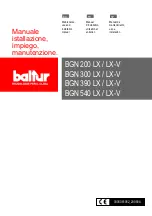
29
outdoor thermostat closes, the high fire on gas
valve opens and the furnace operates in the
high fire mode at higher blower speed.
5.
Timed staging configuration – For this installa-
tion, the low and high on the gas valve are
connected in parallel with a delay on make timer
(two wire style) in series with the low fire gas
valve (See Figure 32).
CAUTION:
DO NOT
CONNECT W2 from thermostat to the furnace
wiring when using timed stage configuration.
When the low fire on the gas valve is energized,
the furnace operates in the low fire mode at a
lower blower speed and the timer begins its
delay function. If the room thermostat is not
satisfied before the timer activates, the furnace
will stage to high fire and the blower will operate
at a higher speed until the room thermostat is
satisfied.
Install the thermostat per the manufacturer's
instructions. The low voltage (24 volt) connec-
tions from the thermostat are made at the
terminal strip on the control board in the fur-
nace. See Figures 28-32 for the proper con-
nections for heating only (four wire) and heat-
ing/cooling (five wire) applications. The rec-
ommended minimum wire gauge for thermo-
stat wiring is shown in Table 10.
The thermostat must not be installed on an
outside wall or any other location where its
operation may be adversely affected. Adverse
affects include radiant loading from fireplaces,
sunlight, or lighting fixtures, and convective load-
ing from warm air registers or electrical appli-
ances.
To check the heat anticipator setting either:
1. Add the current draw of the system compo-
nents; or
2. Measure the current flow on the thermostat R-
W circuit after the circulating blower motor has
started.
Set the heat anticipator according to the ther-
mostat manufacturer's instructions for heat
anticipator settings.
START-UP AND ADJUSTMENTS
General
Prior to start-up, verify that:
1. The line voltage power leads are securely
connected, that the polarity of the connections
is correct, and that the furnace is properly
grounded.
2. The thermostat wires (R, W, Y, and G) are
securely connected to the correct leads on the
terminal strip of the circuit board.
3. The gas line service pressure does not exceed
10.0 in. water column (0.36 psig), and is not less
than 4.5 in. water column (0.16 psig) for natural
gas. For LP gas the line service pressure must
not exceed 14 in. water column (0.51 psig), and
must not be less than 11.0 in. w.c. (0.40 psig).
4. The roll-out and vent safety manual reset
switches are closed. If necessary, press the
red button to reset a switch. DO NOT install a
jumper wire across a switch to defeat its
function. If a switch reopens on start-up, DO
NOT reset the switch without identifying and
correcting the fault condition which caused the
switch to trip.
5. The blower door is in place, closing the door
switch in the line voltage circuit.
6. The gas line has been purged and all connec-
tions are leak tight.
Start-up Procedures
After all of the above checks have been made:
1. Set the thermostat to the lowest setting.
2. Close the disconnect(s) to provide line voltage
to the furnace.
3. Follow the procedures given on the operating
instruction label attached to the furnace.
4. Set the thermostat above room temperature
and verify the operating sequence. (See the
Sequence of Operation).
5. After the furnace has run for approximately five
minutes, set the thermostat below room tem-
perature and verify steps (9) through (11) of the
Sequence of Operation.
Verifying and Adjusting Firing Rate
The firing rate must be verified for each installation
to prevent over-firing the furnace.
IMPORTANT NOTE:
The firing rate must not exceed the rate
shown on the furnace rating plate. At alti-
tudes above 2000 feet it must not exceed
that on the rating plate less 4% for each
1000 feet.
Follow the procedure below to determine the
firing rate.
1. Shut off all other gas fired appliances.
2. Start the furnace and allow it to run for at least
three minutes.
3. Measure the time (in seconds) required for the
gas meter to complete one revolution.
Summary of Contents for TA-060C-08A
Page 2: ...2...












































